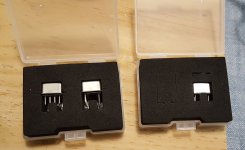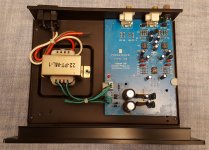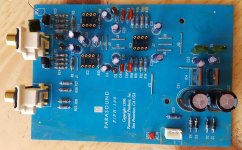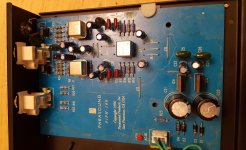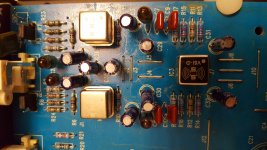This is a review of the Burson Audio Supreme Sound V5i hybrid-discrete op amps in a phono stage application. I have seen several other reviews using these amps in headphone amps, DACs, and computer sound cards, but not many reports in a purely analog system for a turntable. I extend my thanks to Burson for providing the op amps to audition in exchange for a detailed, honest review. I have no affiliation with the company.
Background: I am setting out to purchase a new turntable and cartridge with something higher end than my current B&O 2400. As such, I will need a better phono stage. Eventually I will research and probably build something. In the meantime as a stop-gap I picked up a used Parasound PPH-100 which looks like has some capability for further DIY improvements (many laid out here Plexus Parasound PPH-100 Modifications). I wanted to start with the lowest-hanging fruit, being an op amp swap for something quieter and faster. This led me to discover Burson Audio and get curious about their discrete and “hybrid” discrete op amps. I decided to try out replacing stock integrated circuit NE553 op amps with Burson model v5i.
Primary test component: Parasound PPH-100 phono stage, replacing NE553 op amps with Burson V5i hybrid “discrete” op amps (2x single & 1x dual).
Testing system: Bang & Olufsen 2400 with MC20EN cartridge (moving iron, running at moving magnet gain), DIY 16 WPC tube amplifier, Monitor Audio Bronze II speakers.
I received the op amps in sturdy packaging, soldered sockets into the PCB and placed the op amps. First impression after soldering and initial power-on is some audible hum. My tube amplifier has tone settings for bass and treble that are usually used near the top end of the potentiometers. I turned these down as well as the volume below the threshold where the hum disappeared. Turning on the source, the music plays at regular listening levels with my amplifier levels turned down significantly from where they previously were used. These op amps are putting out a hotter signal than what they replaced. It will require some readjustment to my standard amp volume and tone listening levels but has resulted in greater useful range there -- no longer do I need or wish to keep the tone levels way up. I can experiment with tuning them to my liking across the full potentiometer dials based on the source material.
The initial listening was Live’s Throwing Copper album. This is not my choice for critical listening but it happened to be on the TT when I first checked out the preamp after op-amp replacement. The instant impression was of clearer vocals -- this effect was striking. The overdriven guitar was better separated from the bass. I heard reverb on the toms and cymbals never noticed before. Dynamic changes in volume from quiet to loud passages were more significant. The new op amps were not broken in and this is not a reference album I would plan to use for a review, but I was already impressed. My wife (a frequent listening companion but lacking as critical an ear) could hear more soundstage space between instruments, especially the vocals.
Burson recommends 100 hours for full burn-in. I didn’t hear any strongly noticeable changes during the break in period, but I was also listening through it all to a lot of different material so any changes were more subtle than the initial big change in sound from swapping in these op amps.
After 100 hrs, some specific notes on my go-to reference albums:
Arne Domnerus, Jazz at the Pawnshop: reed instruments were more enunciated like vocals the in the initial listening album. Room ambiance and jazz club audience at very low volume levels compared to the instruments were more clearly depicted rather than just above noise floor previously.
Cowboy Junkies, Trinity Session: better reproduction of all the features that make this album one of my favorite references. The room reverb and ambiance of the Trinity Chapel recording space was revealed with more nuances. Beautiful vocal tracks were really carved out in the soundstage.
Acoustic Research, Sounds of Musical Instruments Test Album: high realism from strings including pizzicato and transients.
Nick Drake, Pink Moon: voice and acoustic plucking were better spaced. Subtle fret sounds and harmonics from the guitar were more available to hear.
Conclusion: The influence of the V5i op amps is similar through many different records and genres. Though not all reviewed in detail, I also listened to many albums across the genres and date ranges of vinyl. The characteristics of the V5i op amps are well generalized in description that they bring out lower level details that add realism and naturalism to sounds. The difference shines better in organic sounds like vocals, strings and reed instruments than in electronic music and synthesized bass (the electronic genres don’t sound any worse, just less changed by the op amp swap). There is greater space between all instruments but especially vocals. Sound volume runs hotter than other IC op amps (at least in this preamp circuit), so be prepared to potentially re-adjust volume and tone settings to adapt to new listening preferences, or perhaps even to change a resistor to readjust the preamp gain level. While the Parasound PPH-100 is one (older) example that I tested here, it is likely that other current market phono preamps in the entry-level price point also employ IC op-amps that could be improved with a substitution.
Additional side notes of the experience:
With no source playing and power amp volume turned up to mid-level, I heard some interesting periodic chattering noises -- only with no source. I have only experienced this phenomenon at home with these V5i op amps in. Burson customer service was helpful and their technical staff suggested some capacitance changes on the op amp rails that might mitigate the issue. I later took the preamp over to a friend’s system and the unwanted sounds were completely absent, indicating that something else in my home setup was probably the issue. Perhaps an RF interference issue with surrounding equipment and cabling. It could be that the interference sound was always present but I wasn’t hearing it until highlighted by the louder output Burson op-amps.
I set up this preamp at the friend’s home to audition his turntable and cartridge, which I plan to purchase the same. I can now add to this review with more limited listening that the PPH-100 preamp with the V5i op amps is also low noise and sonically good in higher gain MC mode in a system higher caliber than my current home setup. Though maybe not 100% as sonically robust, the inexpensive PPH-100 with V5i holds its own and sounds similar against a $1200 Musical Surroundings Nova II preamp with discrete amplification. (Tested with: Acoustic Signature Primus TT, Lyra Delos cartridge, Electrocompanient 6D power amp, Audio Physik Classic 20 speakers, Transparent interconnects).
I will be leaving these op amps in the circuit and am quite pleased with the sonic results in the music. I also popped some 2604/604 into the circuit which sounded better than stock NE553 but not as good as the V5i. I feel no need to go out straight and spend $1000+ on a new preamp to “match” the new TT and cartridge. My only slight regret is not going instead to try the newer, V6 discrete model higher in the Burson line. I chose the V5i for case fit, but in retrospect some case or circuit modifications to fit a larger Burson discrete op amp would have been worth the effort if it would have provided even more of the same characteristic improvements to the sound. I won’t hesitate to swap Burson op amps into other audio electronics with ICs that I may encounter in the future.
Background: I am setting out to purchase a new turntable and cartridge with something higher end than my current B&O 2400. As such, I will need a better phono stage. Eventually I will research and probably build something. In the meantime as a stop-gap I picked up a used Parasound PPH-100 which looks like has some capability for further DIY improvements (many laid out here Plexus Parasound PPH-100 Modifications). I wanted to start with the lowest-hanging fruit, being an op amp swap for something quieter and faster. This led me to discover Burson Audio and get curious about their discrete and “hybrid” discrete op amps. I decided to try out replacing stock integrated circuit NE553 op amps with Burson model v5i.
Primary test component: Parasound PPH-100 phono stage, replacing NE553 op amps with Burson V5i hybrid “discrete” op amps (2x single & 1x dual).
Testing system: Bang & Olufsen 2400 with MC20EN cartridge (moving iron, running at moving magnet gain), DIY 16 WPC tube amplifier, Monitor Audio Bronze II speakers.
I received the op amps in sturdy packaging, soldered sockets into the PCB and placed the op amps. First impression after soldering and initial power-on is some audible hum. My tube amplifier has tone settings for bass and treble that are usually used near the top end of the potentiometers. I turned these down as well as the volume below the threshold where the hum disappeared. Turning on the source, the music plays at regular listening levels with my amplifier levels turned down significantly from where they previously were used. These op amps are putting out a hotter signal than what they replaced. It will require some readjustment to my standard amp volume and tone listening levels but has resulted in greater useful range there -- no longer do I need or wish to keep the tone levels way up. I can experiment with tuning them to my liking across the full potentiometer dials based on the source material.
The initial listening was Live’s Throwing Copper album. This is not my choice for critical listening but it happened to be on the TT when I first checked out the preamp after op-amp replacement. The instant impression was of clearer vocals -- this effect was striking. The overdriven guitar was better separated from the bass. I heard reverb on the toms and cymbals never noticed before. Dynamic changes in volume from quiet to loud passages were more significant. The new op amps were not broken in and this is not a reference album I would plan to use for a review, but I was already impressed. My wife (a frequent listening companion but lacking as critical an ear) could hear more soundstage space between instruments, especially the vocals.
Burson recommends 100 hours for full burn-in. I didn’t hear any strongly noticeable changes during the break in period, but I was also listening through it all to a lot of different material so any changes were more subtle than the initial big change in sound from swapping in these op amps.
After 100 hrs, some specific notes on my go-to reference albums:
Arne Domnerus, Jazz at the Pawnshop: reed instruments were more enunciated like vocals the in the initial listening album. Room ambiance and jazz club audience at very low volume levels compared to the instruments were more clearly depicted rather than just above noise floor previously.
Cowboy Junkies, Trinity Session: better reproduction of all the features that make this album one of my favorite references. The room reverb and ambiance of the Trinity Chapel recording space was revealed with more nuances. Beautiful vocal tracks were really carved out in the soundstage.
Acoustic Research, Sounds of Musical Instruments Test Album: high realism from strings including pizzicato and transients.
Nick Drake, Pink Moon: voice and acoustic plucking were better spaced. Subtle fret sounds and harmonics from the guitar were more available to hear.
Conclusion: The influence of the V5i op amps is similar through many different records and genres. Though not all reviewed in detail, I also listened to many albums across the genres and date ranges of vinyl. The characteristics of the V5i op amps are well generalized in description that they bring out lower level details that add realism and naturalism to sounds. The difference shines better in organic sounds like vocals, strings and reed instruments than in electronic music and synthesized bass (the electronic genres don’t sound any worse, just less changed by the op amp swap). There is greater space between all instruments but especially vocals. Sound volume runs hotter than other IC op amps (at least in this preamp circuit), so be prepared to potentially re-adjust volume and tone settings to adapt to new listening preferences, or perhaps even to change a resistor to readjust the preamp gain level. While the Parasound PPH-100 is one (older) example that I tested here, it is likely that other current market phono preamps in the entry-level price point also employ IC op-amps that could be improved with a substitution.
Additional side notes of the experience:
With no source playing and power amp volume turned up to mid-level, I heard some interesting periodic chattering noises -- only with no source. I have only experienced this phenomenon at home with these V5i op amps in. Burson customer service was helpful and their technical staff suggested some capacitance changes on the op amp rails that might mitigate the issue. I later took the preamp over to a friend’s system and the unwanted sounds were completely absent, indicating that something else in my home setup was probably the issue. Perhaps an RF interference issue with surrounding equipment and cabling. It could be that the interference sound was always present but I wasn’t hearing it until highlighted by the louder output Burson op-amps.
I set up this preamp at the friend’s home to audition his turntable and cartridge, which I plan to purchase the same. I can now add to this review with more limited listening that the PPH-100 preamp with the V5i op amps is also low noise and sonically good in higher gain MC mode in a system higher caliber than my current home setup. Though maybe not 100% as sonically robust, the inexpensive PPH-100 with V5i holds its own and sounds similar against a $1200 Musical Surroundings Nova II preamp with discrete amplification. (Tested with: Acoustic Signature Primus TT, Lyra Delos cartridge, Electrocompanient 6D power amp, Audio Physik Classic 20 speakers, Transparent interconnects).
I will be leaving these op amps in the circuit and am quite pleased with the sonic results in the music. I also popped some 2604/604 into the circuit which sounded better than stock NE553 but not as good as the V5i. I feel no need to go out straight and spend $1000+ on a new preamp to “match” the new TT and cartridge. My only slight regret is not going instead to try the newer, V6 discrete model higher in the Burson line. I chose the V5i for case fit, but in retrospect some case or circuit modifications to fit a larger Burson discrete op amp would have been worth the effort if it would have provided even more of the same characteristic improvements to the sound. I won’t hesitate to swap Burson op amps into other audio electronics with ICs that I may encounter in the future.
Attachments
AudioKarma CNC Phono Stage - Side 22
Use Google translator from Norwegian to English.
Read from post 430.
Use Google translator from Norwegian to English.
Read from post 430.
There's plenty of diy phonostages on these pages that will show that $30 worth of parts parasound a clean pair of bells. Many of them for less than those opamps.
What's your top pick? Or some differentiating characteristics of some you have experience with? I'm researching and planning for what comes next, hopefully a build vs a purchase since I enjoy that.
- Status
- This old topic is closed. If you want to reopen this topic, contact a moderator using the "Report Post" button.
